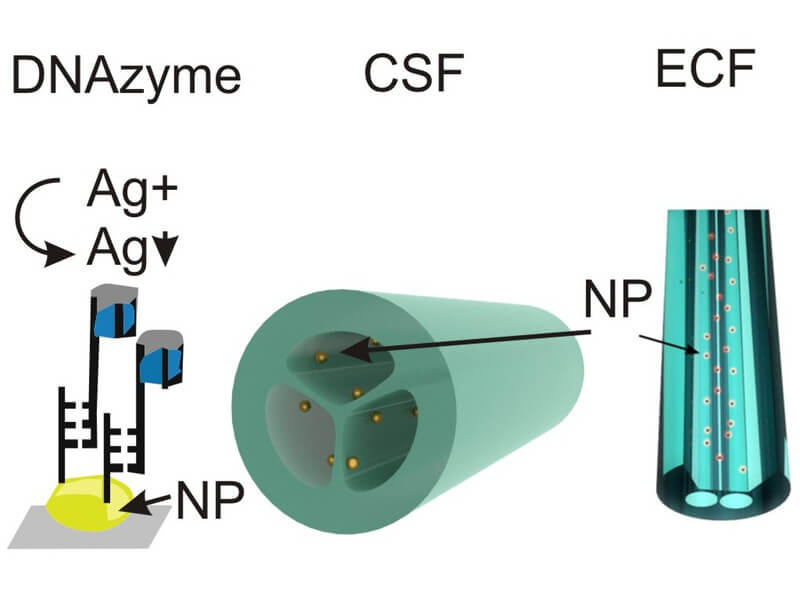- Home
- Research
- Fiber Photonics
- Research results
- Localized Surface Plasmon-based Sensing
Localized Surface Plasmon-based Sensing

23.04.2018
An immobilized ensemble of gold nanoparticles is used as a highly-sensitive plasmon-based refractive index sensor. Adsorption of molecules on the surface of the nanoparticles induces a refractive index change, therefore, this concept can also be applied to detect biomolecules. A quest for the detection of the ultra-low concentration of molecules demands increasing sensitivity of these sensors. Therefore, we investigated several approaches, which are promising with respect to the improvement of localized surface plasmon-based sensors.
By: Ondrej Stranik // Brenda Doherty // Andrea Csaki
Small metallic nanoparticles (NPs) possess special optical properties not present in bulk metal materials. They resonantly absorb and scatter light, which is referred to as localized surface plasmon resonance (LSPR), at a specific wavelength, giving them a specific color. This color changes upon adsorption of nanometer-thin layers on the nanoparticles; therefore, they can be exploited for label-free detection of biomolecules. Nanoparticles that are modified with bio-recognition receptors are brought into contact with the investigated sample and spectroscopically measured. The nanoparticles’ color change indicates the presence of the sought analyte. Recent investigations on LSPR sensing were focused in two directions. The first focus of research was the increase in the detection sensitivity by the incorporation of a peroxidase-mimicking DNAzyme in the DNA detection scheme [1]. The DNAzyme is a complex formed by a specific DNA (G quadruplex-forming DNA) and by a hemin molecule. Our research showed that the DNAzyme is able to catalyze silver deposition on gold metallic nanoparticles. This effect can be exploited by enhancing the LSPR detection of specific DNA. The advantages of using DNAzymes as opposed to classic enzymatic proteins as labels include their thermal stability and simple incorporation with DNA molecules. In classic LSPR detection of DNA, the binding of specific DNA causes a shift in the plasmon resonance peak by a few nm. However, the additional silver deposition on the NP, initiated by the DNAzyme labels, causes a large shift in the plasmon resonance or even a complete change in the resonance peak. The topological characterization of the deposited silver showed that the silver shell grown on 100 nm of gold NP with a DNAzyme exhibits a strongly anisotropic star-like shape with an average thickness of 20 nm.
The second focus was the enhancement of optical detection by incorporating metallic nanoparticles into novel microstructured optical fibers, such as suspended-core [2] and exposed-core [3] fibers. The suspended core fibers (SCFs) are microstructured fibers containing axial air channels, which extend along the fiber length and have diameters of several tens of micrometers. These channels are arranged in such a way as to form a central glass core, in which the propagating mode deeply evanescently penetrates the air channels. The SCF promises a compact, easy-to-use LSPR sensing platform because its geometry allows efficient optical excitation of LSPR in NPs deposited inside the fiber. The geometry can be used simultaneously for effective delivery of the minute volume of a liquid sample to the NPs. We were able to homogenously deposit gold NPs across several meters along the SCFs with controllable NP density. This was important because a density of the deposited NPs that is too high would lead to complete vanishing of the light propagation through the SCF fibers. This LSPR sensing platform exhibited an enhanced signal response to the refractive index change in the fluid inside the SCF (167 nm/RIU) compared to the light not guided through the fibers (an enhancement that is about 1.5 times higher). Another variation of this idea was to use exposed-core fibers (ECFs), which are similar to SCFs, but their air channels are axially open. This feature has the additional advantage of the control of the axial confinement of NP deposition on the fiber. The measured refractive index sensitivity in these ECFs achieved 200 nm/RIU.
Funded by: BMBF, AIF
